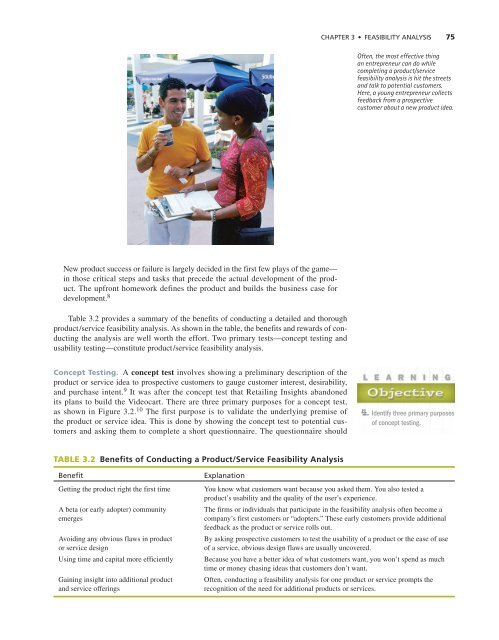feasibility analysis feasibility analysis
feasibility analysis feasibility analysis
feasibility analysis feasibility analysis
You also want an ePaper? Increase the reach of your titles
YUMPU automatically turns print PDFs into web optimized ePapers that Google loves.
CHAPTER 3 • FEASIBILITY ANALYSIS 75<br />
Often, the most effective thing<br />
an entrepreneur can do while<br />
completing a product/service<br />
<strong>feasibility</strong> <strong>analysis</strong> is hit the streets<br />
and talk to potential customers.<br />
Here, a young entrepreneur collects<br />
feedback from a prospective<br />
customer about a new product idea.<br />
New product success or failure is largely decided in the first few plays of the game—<br />
in those critical steps and tasks that precede the actual development of the product.<br />
The upfront homework defines the product and builds the business case for<br />
development. 8<br />
Table 3.2 provides a summary of the benefits of conducting a detailed and thorough<br />
product/service <strong>feasibility</strong> <strong>analysis</strong>. As shown in the table, the benefits and rewards of conducting<br />
the <strong>analysis</strong> are well worth the effort. Two primary tests—concept testing and<br />
usability testing—constitute product/service <strong>feasibility</strong> <strong>analysis</strong>.<br />
Concept Testing. A concept test involves showing a preliminary description of the<br />
product or service idea to prospective customers to gauge customer interest, desirability,<br />
and purchase intent. 9 It was after the concept test that Retailing Insights abandoned<br />
its plans to build the Videocart. There are three primary purposes for a concept test,<br />
as shown in Figure 3.2. 10 The first purpose is to validate the underlying premise of<br />
the product or service idea. This is done by showing the concept test to potential customers<br />
and asking them to complete a short questionnaire. The questionnaire should<br />
4. Identify three primary purposes<br />
of concept testing.<br />
TABLE 3.2 Benefits of Conducting a Product/Service Feasibility Analysis<br />
Benefit<br />
Getting the product right the first time<br />
A beta (or early adopter) community<br />
emerges<br />
Avoiding any obvious flaws in product<br />
or service design<br />
Using time and capital more efficiently<br />
Gaining insight into additional product<br />
and service offerings<br />
Explanation<br />
You know what customers want because you asked them. You also tested a<br />
product’s usability and the quality of the user’s experience.<br />
The firms or individuals that participate in the <strong>feasibility</strong> <strong>analysis</strong> often become a<br />
company’s first customers or “adopters.” These early customers provide additional<br />
feedback as the product or service rolls out.<br />
By asking prospective customers to test the usability of a product or the ease of use<br />
of a service, obvious design flaws are usually uncovered.<br />
Because you have a better idea of what customers want, you won’t spend as much<br />
time or money chasing ideas that customers don’t want.<br />
Often, conducting a <strong>feasibility</strong> <strong>analysis</strong> for one product or service prompts the<br />
recognition of the need for additional products or services.

















